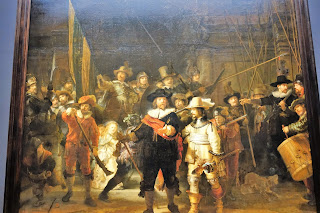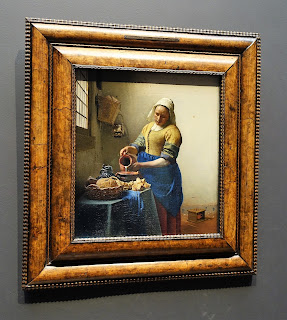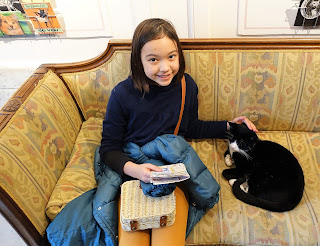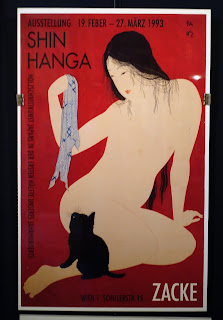Rembrandt's "The Night Watch" (1642) at the Rijksmuseum
With just one full day on our brief visit devoted to seeing (a few of) the sights of Amsterdam, the question was where to go first. Perhaps inspired by the fact that we had spent the night in the Vermeer Room at the Hotel Brouwer, the decision was made to see some of the works of the noted Dutch masters, and that meant paying a visit to the city's famed Rijksmuseum (National Museum), "the Netherlands' premier art trove" (according to Lonely Planet). So following breakfast, we took a walk along the Singel canal in the direction of the museum. Some of the houses have a distinct tilt to them:
Blessed are the cheesemakers...:
If the exterior of the Rijksmuseum bears a resemblance to a certain central train station in Amsterdam, it's because both buildings were designed by the same architect, Pierre Cuypers:
The museum was opened in 1885. It holds more than 7500 works of art displayed in over 1.5 kilometers of galleries. In other words, there's a lot to see. Crowds must be horrendous in the summer, but in late November we were able to get tickets without having to wait in line. We began in the Asian Pavilion:
The massive Battle of Waterloo by Jan Willem Pieneman (1824), depicting the Duke of Wellington receiving the news that the Prussians are on their way:
A mock-up of the Dutch trading post on the artificial island of Dejima 出島, which was located in the bay of Nagasaki 長崎. From 1641 to 1853, the Netherlands was the only Western nation permitted to trade directly with Japan during the Edo period 江戸時代:
There were three prints by Vincent Van Gogh on display at the Rijskmuseum, which went a little way toward making up for the fact that we didn't have time to visit the nearby Van Gogh Museum (more on that later). Self-Portrait with Grey Felt Hat (1886-7):
I neglected to note the titles of the other two works, however, but here they are:
The main reason to visit the Rijksmuseum, of course, is to see the works from the Dutch Golden Age, such as The Milkmaid (1657 or 1658) by Johannes Vermeer:
Woman in Blue Reading a Letter (1663-4), also by Vermeer, a reproduction of which was hanging on the wall of our hotel room (we were staying in the Vermeer Room, after all):
The Merry Family (1668), Jan Steen:
The Jewish Bride (1667), Rembrandt:
And, of course, Company of Frans Banning Cocq, or as it's better known these days, The Night Watch. The popularity of Rembrandt's masterpiece meant that it was difficult to get a shot without the admiring crowds:
The amazing library:
A view of the outside from one of the upper-floor windows:
An intricately-detailed dollhouse:
Two examples of Delftware with Chinese themes. The Dutch, of course, played a major role (albeit a not always positive one) in the early development of Taiwan through their colonization of Formosa from 1624 to 1662:
Having lunch at a restaurant down the street from the Rijskmuseum and discussing where to go next. I was hoping to visit the Van Gogh Museum, but the girls had had enough masterpieces for one afternoon, with my wife claiming not to understand "Western art". Amber, to her credit, expressed an interest in traveling to Den Haag in order to see Vermeer's Girl with a Pearl Earring at the Mauritshuis museum (and I would've liked to have seen the Escher in Het Paleis Museum to see the works of one of my favorite artists, MC Esher), but our itinerary was such that it wasn't possible on this trip:
And so the decision was made (by my daughter) that we should next visit KattenKabinet (Cat Cabinet), an offbeat museum devoted to cats in art. The collection is housed in a building dating from 1667, and was founded by financier Bob Meijer in 1990 in memory of his red tomcat John Pierpoint Morgan III. The presence of three very much alive felines complemented the artistic renditions:
In the KattenKabinet's collection can be found Picasso's Le Chat...:
...and a small etching by none other than Rembrandt, entitled Madonna with Child, Cat and Snake (1654):
The KattenKabinet is located in a neighborhood known as the Golden Bend (Gouden Bocht), which Lonely Planet describes as "the most prestigious stretch of real estate in Amsterdam, a monument to the Golden Age, when precious goods swelled in cellars of homes already stuffed with valuables. The richest Amsterdammers lived and ruled their affairs from here.":
We took a walk around the neighborhood near the Golden Bend, where I purchased a new raincoat for more euros than I care to admit (our trip to the Netherlands served as a reminder of how relatively cheap it is to eat out and shop in Lithuania!), before returning to the Hotel Brouwer:
After dinner, Shu-E wanted to wash her hair and relax in the room, so Amber and I strolled over to the Dam, in Amsterdam's central square, dominated by the massive Royal Palace (Koninklijk Paleis), to admire the evening lights in the cold night air:
Amsterdam is one of those intriguing cities in which we only had time to scratch the surface of what there is to see and do. I wouldn't hesitate to put it on the list of places to return to someday, though my wife didn't seem to share my enthusiasm (she preferred Maastricht, not to mention the Dutch countryside):
Dutch treat:
































Wow, amazing looking place! The cat cabinet looks like it was worth a visit as well!
ReplyDeleteAmsterdam was great. Stop watching "Air Crash Investigation" and come visit me and Jeff in Europe!
Delete